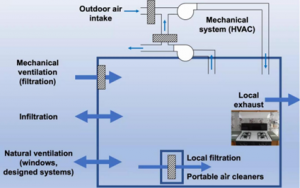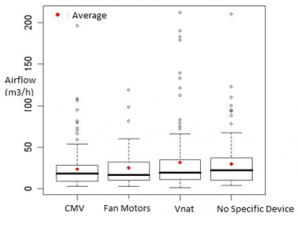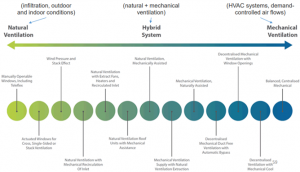Author: Mahrar Salim
Since the pandemic, ventilation has been a major concern for Quebec residents. As a result, the Quebec government has invested several million dollars in public funds to equip public places, including schools, with mechanical ventilation where over 54% of them have no ventilation system at all.
Indeed, indoor air quality is a subject that must be taken very seriously. Moreover, according to the World Health Organization, indoor air pollution is responsible for 3.2 million deaths per year, including over 237,000 children under 5 years old. Thus, indoor air quality has a direct impact on your health, as well as on your productivity at work. Furthermore, we spend on average more than 90% of our time indoors, particularly during the winter period in Quebec.
As a reader of this article, you are certainly wondering what your options are to ensure adequate indoor air quality. Thus, to mitigate the risk, two choices are available: natural ventilation and/or mechanical ventilation. The idea of this article is to determine if mechanical ventilation is indispensable for indoor air quality control?
To begin, some definitions are necessary. “Ventilation is the process of supplying air to or removing air from a space for the purpose of controlling air contaminant levels, humidity, or temperature within the space” (ASHRAE, 2022). Therefore, various types of processes can fulfill the role of ventilation.

Figure 1.1 The different systems providing ventilation excluding local filtration (Persily, s.d).
Mechanical ventilation systems can ensure regular and precise air exchange rates, thereby aiding in the elimination of contaminants and preserving a healthy indoor atmosphere. Two types of mechanical ventilation systems are available: central systems that circulate air throughout an entire structure (HVAC), and local exhaust systems that remove impurities from designated areas such as bathrooms or kitchens. There are several types of mechanical ventilation systems. We will discuss the various advantages and disadvantages of mechanical ventilation.
Firstly, the use of mechanical ventilation is beneficial for enclosed spaces that are isolated from the outdoors. Similarly, when outdoor pollution levels are high.
Additionally, certain types of mechanical ventilation enable control over humidity levels. Thus, in winter, it helps maintain a suitable humidity level to prevent the development of certain bacteria or viruses mentioned below.

Figure 1.2 Optimum Relative Humidity (Sterling, 1985)
The figure above shows that it is necessary to maintain a humidity level between 40% and 60% inside homes to reduce health risks and avoid the development of certain bacteria, viruses, or fungi.
Certain mechanical ventilation systems, equipped with heat recovery, also allow for savings on building heating costs.
However, everything is not perfect, mechanical ventilation has some drawbacks. Firstly, installation costs can be very high depending on the requirements. Additionally, apart from installation costs, energy consumption also increases. Finally, one of the most problematic drawbacks is the sizing of mechanical ventilation systems. Indeed, it is difficult to predict the capacity of the room as well as its usage during the design phase. Thus, it is easy to end up with a room with a ventilation system that is more substantial than required by the standards. Conversely, the function of a room may change, resulting in an undersized ventilation system.
The second family is that of natural or passive ventilation. Natural ventilation is a system that works passively to circulate air inside a building, using wind and thermal convection as natural forces. This type of ventilation does not require mechanical assistance and instead depends on openings such as windows, doors, and wall vents to facilitate the flow of air. In addition, air infiltration can be considered a type of passive ventilation. However, as homes become increasingly better insulated over the years, infiltration decreases and, as a result, ventilation rates also decrease.
The advantages of natural ventilation mainly lie in very low operating costs. It can also reduce air conditioning costs during the summer. As for the disadvantages, it is difficult to naturally ventilate an isolated room, and its use relies on the behavioral aspect of users. Therefore, it is suggested to install CO2 sensors in rooms to prompt users to ventilate when a certain threshold has been reached.
As a customer, one might tend to think that mechanical ventilation is more efficient than natural ventilation. A study was conducted to compare the efficiency of different ventilation systems based on the airflow they provide. Therefore, 447 households were observed during the night with 4 different types of ventilation: centralized mechanical ventilation, fan motors in some rooms only, a natural ventilation system (air vents), or no specific device relying solely on the opening of doors and windows.

Figure 1.3 The distribution of airflow rates according to the type of ventilation (OQAI, 2009).
The results show that the airflow is relatively similar between natural and mechanical ventilation systems. The usefulness of one or the other depends primarily on the type of use of the room or its situation, which will lean towards a particular type of system.
It is difficult to estimate the effectiveness of one system or another because homes tend to have a hybrid system. The usefulness of the study is essentially to demonstrate that both types of systems can be effective for ventilation.

Figure 1.4 Ventilation strategies
The figure above demonstrates that ventilation systems are often combinations of natural and mechanical ventilation.
To conclude, mechanical ventilation is not essential. However, depending on the nature of the activities performed indoors, it may be necessary. The choice of a hybrid system is interesting because it allows for the benefits of both natural and mechanical ventilation. Your choice should therefore be based primarily on your estimated needs, but also on budget and the nature of the activities you wish to perform. Consultation with an expert is suggested to accurately estimate your needs to maintain good indoor air quality. The expert may be able to save you some dollars from your wallet. Always invest in your health!
References
AREC IDF. (2012, February). Ventilation naturelle et mécanique. Retrieved from https://www.arec-idf.fr/fileadmin/DataStorageKit/AREC/Etudes/pdf/guide_bio_tech_ventilation_naturelle_et_mecanique.pdf
ASHRAE. (2022). The Standards for Ventilation and Indoor Air Quality. Retrieved from Standards 62.1 & 62.2 : https://www.ashrae.org/technical-resources/bookstore/standards-62-1-62-2.
EEABS. (s.d.). Natural Ventilation Simulations. Retrieved from : https://eeabs.co.uk/natural-ventilation-simulations/
Government of Canada. (2018, March). Ventilation and the indoor environment. Retrieved from : https://www.canada.ca/en/health-canada/services/publications/healthy-living/ventilation-indoor-environment.html
OQAI. (2009, June). Impact de la ventilation sur la pollution intérieure des maisons françaises. Retrieved from : Observatoire de la qualité intérieur : https://www.oqai.fr/fr/campagnes/l-impact-de-la-ventilation-sur-la-pollution-interieure-des-maisons-francaises
Persily, A. K. (s.d.). NIST. Retrieved from : https://www.nist.gov/people/andrew-k-persily
Sterling EM, A. A. (1985). Criteria for Human Exposure to Humidity in Occupied Buildings. Retrieved from : Scientific studies : https://www.condairgroup.com/humidity-health-wellbeing/scientific-studies/criteria-for-human-exposure-to-humidity-in-occupied-buildings#:~:text=If%20your%20workplace%20humidity%20is,you%20can%20do%20about%20it.&text=The%20review%20provides%20good%20evidence,is%2040%2D60%25RH.